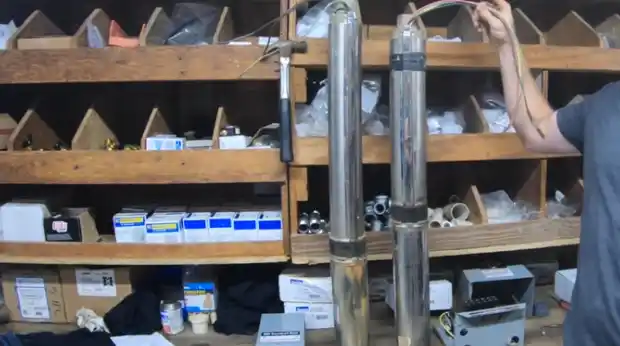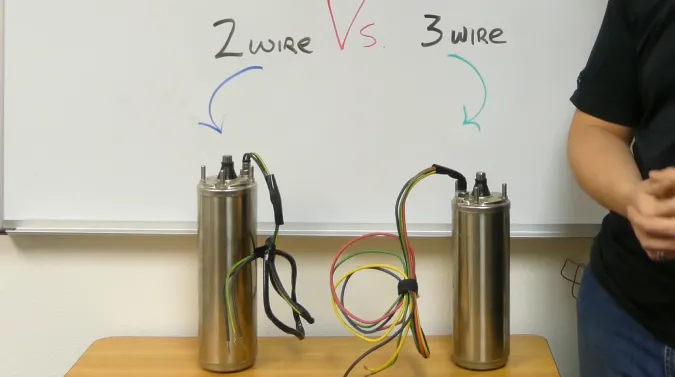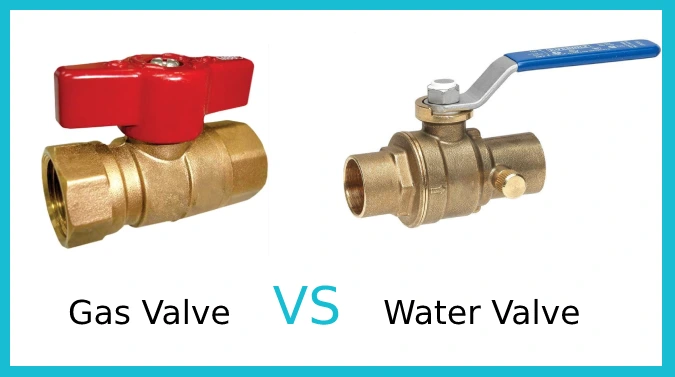Last Updated on July 16, 2023
You’re standing in front of your submersible well pump, figuring out which wires to connect. There are two and three wires, and you’re unsure which is the right choice.
Your decision will affect the efficiency and performance of your well pump, so it’s important to understand the differences between the two options.
The main difference between the two is in the wiring and location of the starting components. 2 wire pumps have starting components inside the motor, while 3 wire pumps have starting components outside the motor.
Other factors to consider include installation and maintenance, horsepower capacity, reliability and failure rates. Understanding these differences can help you determine which type of submersible well pump best suits your needs.
So, let’s dive into the details and explore the world of 2 wire vs 3 wire submersible well pumps.
The Differences Between 2 Wire vs 3 Wire Submersible Well Pump

A submersible well pump is an investment that requires careful consideration. Here are the differences between 2 wire and 3 wire submersible well pumps:
- No 01: Wiring
- No 02: Location of Starting Components
- No 03: Installation and Maintenance
- No 04: Horsepower Capacity
- No 05: Reliability and Failure Rates
- No 06: Torque and Load Handling
- No 07: Cost Considerations
- No 08: Conversion Requirements
No 01: Wiring
The wiring of a submersible well pump is a critical step in the installation process, as incorrect wiring can result in a malfunctioning pump or even cause damage to the pump motor. The key difference between a 2-wire and 3-wire submersible well pump is the number of wires used to power the pump and control box.
A 2-wire submersible well pump has two black wires and a green wire for ground, while a 3-wire submersible well pump has a black, red, yellow, and green wires, with four wires going into the control box and four wires going to the pump.
The additional wires in a 3-wire pump are used for a start capacitor and relay switch located in the control box. The table below summarizes the differences between the wiring of a 2-wire and 3-wire submersible well pump.
No 02: Location of Starting Components
Just like the heart is in the center of the chest, the starting components for a 2-wire pump are housed inside the pump itself. For a 3-wire pump, they are typically found in a control box mounted above ground. This difference in location can significantly impact maintenance and repair.
Accessing 2-wire pump components may require the pump to be pulled out of the well. This can be a time-consuming and expensive process. In contrast, for a 3-wire pump, the control box can be easily accessed above ground, making maintenance and repair much simpler.
No 03: Installation and Maintenance
When it comes to installation, a 2-wire pump may be easier since there is no need for a control box and lighter submersible wire can be used. On the other hand, a 3-wire pump may require a slightly more complex installation due to the control box and heavier submersible wire.
But both types of pumps can be installed with relative ease by following the manufacturer’s instructions and using the proper tools.
In terms of maintenance, a 2-wire pump may require less maintenance since fewer starting components can fail. However, if starting components do fail, the entire motor must be replaced, which can be costly.
In contrast, a 3-wire pump may require more maintenance since more starting components can fail. However, if starting components do fail, only the control box usually needs replacement which is cheaper and easier than replacing the entire motor.
No 04: Horsepower Capacity
You need to know the horsepower capacity of your pump to ensure it can handle your water system demands. The capacity for submersible well pumps depends on the wiring configuration.
A two-wire submersible pump is limited to 1.5 horsepower, while a three-wire configuration can handle higher horsepower ratings, with single-phase motors available up to 15 horsepower.
If you have a larger property or high demand for water, a three-wire submersible pump may be the better choice. However, a two-wire submersible pump may suffice if your water usage is minimal and your property is smaller.
No 05: Reliability and Failure Rates
When maintaining a reliable water system, understanding the potential for component failure is crucial. For example, a three-wire pump may be more prone to failure due to its exposed starting components, as seen in a case study where it failed after just eight years of use.
On the other hand, a 2-wire submersible well pump is considered to have a lower likelihood of component failure than three-wire pumps. This is because the internal components are sealed, which reduces the chances of oxidation and failure.
Furthermore, 2-wire submersible pumps are known for their ability to withstand harsh underground environments. They are less affected by the water’s acidity levels, which can cause corrosion in electrical components.
No 06: Torque and Load Handling

Maximizing the performance of your water system requires understanding the importance of torque and load handling in selecting the right type of motor for your specific application.
2-wire motors with Permanent Split Capacitor or Split Phase motors offer sufficient torque and reliability for residential applications. They are suitable for light to medium loads and can handle water systems requiring shallow water pumping.
On the other hand, 3-wire motors, with Capacitor Start – Induction Run or Capacitor Start – Capacitor Run motors, provide greater starter torque and can handle larger loads. They are suitable for heavier-duty applications and can pump water from greater depths.
No 07: Cost Considerations
If you’re looking for a cost-effective option for your water system, it’s important to consider the long-term expenses associated with motor replacements.
Regarding the wire vs 3 wire submersible well pump debate, the cost considerations can vary. A 2-wire pump may have a lower initial cost, but if the starting components fail, the entire motor will need to be replaced, resulting in a higher long-term cost.
On the other hand, a 3-wire pump may have a higher upfront cost due to the control box. Still, if the starting components fail, replacing the control box is usually lower than replacing the entire motor, making it a more cost-effective option in the long run.
No 08: Conversion Requirements
You’ll need to make some changes to your system to convert your pump from a two-wire to a three-wire submersible well pump. This includes running new wires and installing a control box. While this may seem daunting, the benefits of reliable water access and potential cost savings make it well worth the effort.
The conversion process can be simplified by following a step-by-step guide or seeking professional assistance. It’s important to note that converting a three-wire pump to a two-wire pump is also possible, but it requires capping off an extra wire and may not be as efficient.
Comparison Table between 2 Wire and 3 Wire Submersible Well Pump
| Criteria | 2 Wire | 3 Wire |
| Wiring | Two black wires and a green wire | Black, red, yellow, and green wires |
| Location of Starting Components | Built inside the pump | Housed in a control box above ground |
| Installation | Easier with lighter submersible wire | Slightly more complex with heavier submersible wire |
| Maintenance | Generally lower, but if starting components fail, the entire motor needs to be replaced | Easier and cheaper as only the control box usually needs replacement |
| Horsepower Capacity | Limited to 1.5 HP | Available up to 15 HP for single-phase motors |
| Reliability | Lower likelihood of component failure, sealed internal components | Starting components exposed to above-ground elements, more susceptible to oxidation and failure |
| Torque and Load Handling | Suitable for residential applications | Greater starter torque, can handle larger loads |
| Cost | Generally less expensive initially, but higher cost if starting components fail | Potentially higher upfront cost, but lower cost if starting components fail |
| Conversion | Requires running new wires and installing a control box | Can be converted to 2-wire by capping off extra wire |
| Motor Protection | Basic protection | Advanced protection |
Can you wire a submersible pump without a capacitor?
Without capacitors, the pump will not be able to start or run properly since the capacitors provide the initial boost of power needed to start the motor and keep it running.
If you attempt to wire the pump without the necessary capacitors, you might cause damage to the motor or other components, which could result in costly repairs or replacement.
To make sure that the control box includes the necessary capacitors, you should check the manufacturer’s specifications or consult with a qualified electrician or pump technician.
If the control box does not have the required capacitors, you must purchase a new control box or have an electrician install the capacitors separately.
What is the typical lifespan of a submersible well pump?
The average life expectancy for a 2-wire residential well pump is 8 to 13 years, while a 3-wire residential well pump can last anywhere from 10 to 15 years.
However, it’s important to note that the lifespan of your submersible well pump can be affected by various factors such as the quality of the pump, the frequency of use, and the maintenance practices performed on the pump.
To extend the lifespan of your submersible well pump, it’s essential to practice regular maintenance. This includes checking the water level and pressure, cleaning the pump, and replacing worn-out parts.
Additionally, it’s important to invest in a high-quality submersible pump that is designed to withstand the wear and tear of regular use and provides efficient performance.
How do I know if my well pump is weak?

A decrease in water pressure and strange noises coming from your water system may indicate that your well pump is losing its strength. A weak well pump can cause several problems that affect your water supply and can lead to costly repairs.
Here are some signs to look out for to determine if your well pump is weak:
Low water pressure: If you notice a decrease in water pressure, the well pump is struggling to push water through the pipes. A weak pump or clogged pipes can cause this.
Air spitting from faucets: If air is spitting from your faucets, then your well pump is drawing in the air instead of water, which can cause damage to the pump.
High energy bills: If your energy bills have suddenly increased, it may be because your well pump is working harder than usual to maintain water pressure. A clogged pipe or a weak pump can cause this.
2 or 3 Wire Submersible Well Pump: Protect Your Well Pump with Informed Choices
The decision between a 2 wire and 3 wire submersible well pump should be based on individual needs and preferences. While 2 wire pumps are simpler to install, 3 wire pumps offer better protection and control. It’s important to weigh the pros and cons and make an informed decision.
Additionally, it is possible to wire a submersible pump without a capacitor, but it may affect the efficiency and longevity of the pump. Speaking of longevity, a submersible well pump typically lasts around 15 years with proper maintenance.
If you suspect that your well pump is weak, there are a few indicators you can look out for, such as a decrease in water pressure, strange noises, and higher energy bills. By monitoring these signs and conducting regular maintenance, you can ensure that your well pump functions properly and reliably for years.
Stay informed and keep your well water flowing smoothly.



